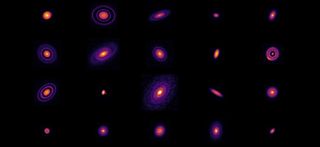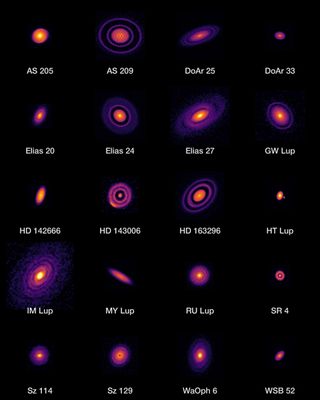Secrets of Planet Birth Revealed in Amazing ALMA Radio Telescope Images

Solving the mystery behind how planets form has just gotten a new boost — and the photos supporting it are stunning.
The Atacama Large Millimeter/submillimeter Array (ALMA) has mapped the planet-formation region around 20 nearby stars in an effort to understand how young worlds are born. The new research comprises one of the deepest surveys ever of protoplanetary disks, the disk of gas and dust where planets are built around newborn stars.
"The goal of this months-long observing campaign was to search for structural commonalities and differences in protoplanetary disks. ALMA's remarkably sharp vision has revealed previously unseen structures and unexpectedly complex patterns," principal investigator Sean Andrews, of the Harvard-Smithsonian Center for Astrophysics (CfA), said in a statement. Working with his colleagues, Andrews studied nearly two dozen nearby disks. They found a wealth of substructures in the disk that could shield the growth of rocky worlds.
"The most compelling interpretation of these highly diverse, small-scale features is that there are unseen planets interacting with the disk material," Andrews said. [Meet ALMA: Amazing Photos from Giant Radio Telescope]
Jump-starting planet formation
Stars form when gravity pulls a cloud of dust and gas together into a new sun. The leftover debris falls into a protoplanetary disk around the star. Under the leading models for planet formation, the dust and gas in the disk gradually pile together to make larger structures, like asteroids, planetesimals and, eventually, planets. This process should take many millions of years, so the scars of planet formation should be most visible on older, more mature systems. Before ALMA, identifying the features of these disks was a challenge.
With its first full-power image, ALMA seemed intent on proving astronomers' theories wrong. In 2012, astronomers released an image of a disk around the million-year old star HL Tau that revealed grooves suggesting planet formation was underway long before anticipated.
"When ALMA truly revealed its capabilities with its iconic image of HL Tau, we had to wonder if that was an outlier since the disk was comparatively massive and young," Laura Perez, an astronomer at the University of Chile and lead author on one of a series of 10 papers describing the survey, said in the statement.
Get the Space.com Newsletter
Breaking space news, the latest updates on rocket launches, skywatching events and more!

Under the Disk Substructures at High Angular Resolution Project (DSHARP), ALMA revealed high-resolution images of 20 nearby protoplanetary disks, showing off a wealth of disk features that provide new insight into which ones are most common and which are less abundant. The results are published in the series of papers, which have been accepted for publication in the Astrophysical Journal Letters.
Depending on the stars' distance from the sun, ALMA was able to distinguish features as small as a few astronomical units [1 astronomical unit, or AU, is equal to the distance from the Earth to the sun, about 93 million miles (150 million kilometers).]
Features such as concentric gaps and narrow rings, like those spotted around HL Tau, are common to nearly all of the disks, the new research revealed. In some cases, large-scale spiral patterns and arc-like features are also present. Disks and gaps appear at a wide range of distances from their star, ranging from a few AU to more than 100 AU, over three times the distance between the sun and Neptune.
Not only do the rings provide insight into the early kick-start of planet formation, they can also explain how rocky planets manage to survive to adulthood, a question that has puzzled astronomers for decades. Once planetesimals grow to about 0.62 miles (1 km) in size, a smooth disk would cause them to fall inward toward their parent star, burning up before they could grow into a rocky planet like Earth.

But the dense rings revealed by ALMA would provide a haven for the massive rocks to safely grow into rocky worlds. The higher densities and the varying concentration of dust particles would create perturbations in the disk, forming regions where the material would have time to become full-fledged planets.
"These latest observations show that, though striking, HL Tau is far from unusual and may actually represent the normal evolution of planets around young stars," Perez said.
Follow Nola Taylor Redd on Twitter@NolaTRedd or Google+. Follow us at@Spacedotcom,FacebookGoogle+. Originally published on Space.com.
Join our Space Forums to keep talking space on the latest missions, night sky and more! And if you have a news tip, correction or comment, let us know at: community@space.com.

Nola Taylor Tillman is a contributing writer for Space.com. She loves all things space and astronomy-related, and enjoys the opportunity to learn more. She has a Bachelor’s degree in English and Astrophysics from Agnes Scott college and served as an intern at Sky & Telescope magazine. In her free time, she homeschools her four children. Follow her on Twitter at @NolaTRedd
